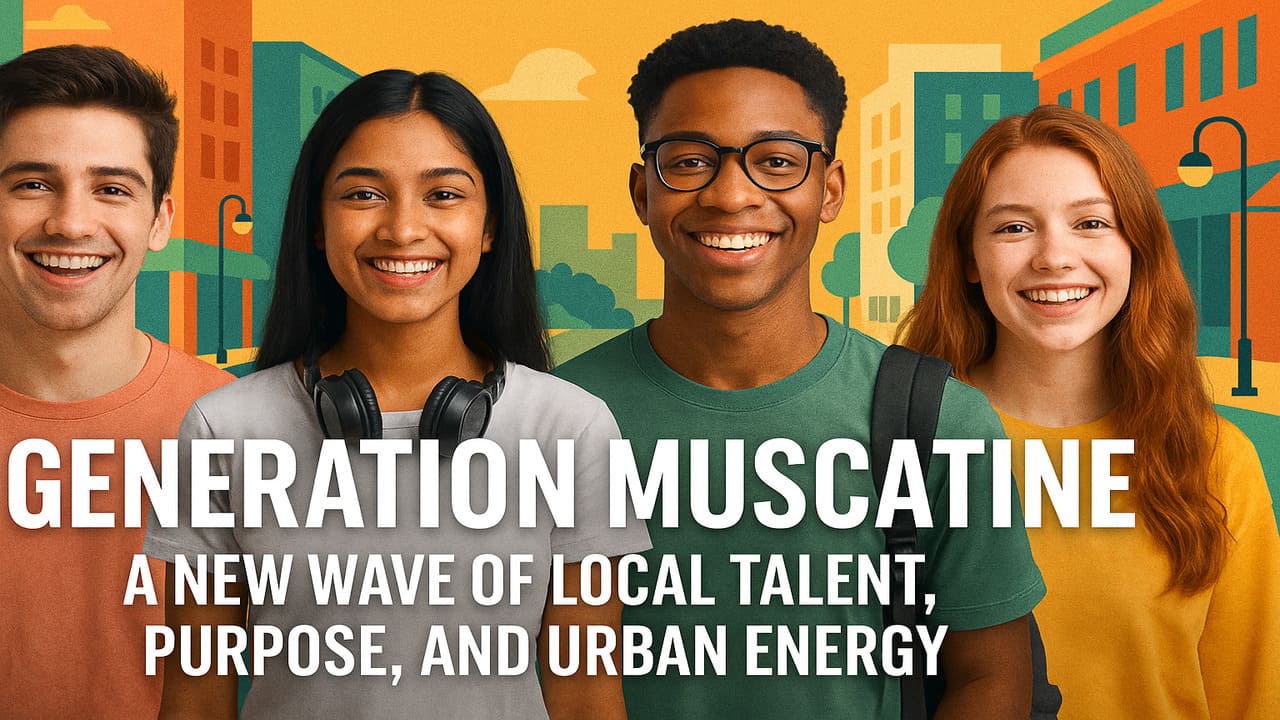
Meet Muscatine – Across art spaces, digital platforms, coffee shops, and community parks, a new generation is actively shaping the city’s identity with creative purpose and vibrant energy. This movement, often informal and community-rooted, is what some now call Generation Muscatine a dynamic. Diverse group of young locals who are building a more expressive and inclusive urban life.
Walk down 2nd Street on a Friday night and you’ll likely hear live acoustic sessions pouring out of small cafés or art collectives exhibiting new works by young creators. Muscatine’s local talent is blossoming in the kinds of places that once went unnoticed converted garages. Public parks and community centers are now hubs for artistic expression and collaboration.
Young musicians are organizing unplugged jam nights at local venues. While visual artists are taking part in public mural projects that reflect both Muscatine’s heritage and its modern aspirations. Events like “River Voices” and “Canvas at the Park” are no longer niche activities they are redefining how the city celebrates itself.
For many of these artists and performers, Muscatine is not just a backdrop. It is their stage, their muse, and the community that validates their vision.
Read More : Gen Z’s New Priorities: Mental Health Over Money
What sets Generation Muscatine apart isn’t just their creativity but their sense of purpose. Social responsibility, environmental advocacy, and mental health awareness are key themes in many of the initiatives led by local youth.
Groups like Green Future Muscatine are composed primarily of high school and college students working on sustainability efforts from riverside cleanups to urban gardening. Meanwhile, digital creators are using social media to spotlight youth mental health, LGBTQ+ inclusivity. And stories of resilience in small-town America.
Whether through activism or community service, these efforts represent more than volunteerism they’re movements built around identity, belonging, and transformation. In many cases, youth-led organizations are filling gaps left by traditional institutions, offering safe, inclusive spaces for dialogue and action.
While Muscatine may not be a sprawling metropolis, it is increasingly feeling like a city in motion, thanks to its young inhabitants. Pop-up markets, creative co-working hubs, and local tech meetups are giving downtown a renewed sense of purpose.
Weekend events like “Maker’s Saturdays” bring together young entrepreneurs, coders, and DIY enthusiasts. Who are eager to showcase products and share ideas. Several locally run coffee shops have evolved into casual innovation hubs. With groups of students and freelancers brainstorming everything from podcasts to digital art portfolios.
There’s a palpable urban rhythm emerging one not marked by traffic or skyline, but by ambition, collaboration, and storytelling. Young people are reframing Muscatine as a place not just to grow up, but to stay, thrive, and make an impact.
Read More : History Nights: Stories by the Riverside That Unite Generations in Muscatine
Of course, this youthful energy doesn’t exist without obstacles. Lack of funding, limited access to formal art or tech programs, and the tendency for talent to migrate to larger cities remain significant challenges. Yet, what Generation Muscatine lacks in resources, it makes up for in community support and ingenuity.
Local businesses, public libraries, and city council initiatives are beginning to take notice. Grants for youth projects, open mic nights sponsored by local organizations. Collaborations with schools are slowly paving the way for more structured growth.
Many young residents voice their hope for more mentorship, faster internet access, and expanded digital literacy programs tools they believe are essential for leveling the playing field in the digital age.
Rather than ending with a conclusion, let us pivot to a topic of growing importance: the role of institutions in amplifying youth-led initiatives. As youth culture gains traction, it’s vital that schools, libraries, local governments. Private sectors ask the right question not “What do young people want to do?” but rather, “How can we help them lead?”
Providing micro-grants, free public spaces for exhibitions and meetings, and mentorship programs are some of the simplest yet most effective strategies. Equally important is respecting the autonomy and creative direction of youth groups without co-opting their visions.